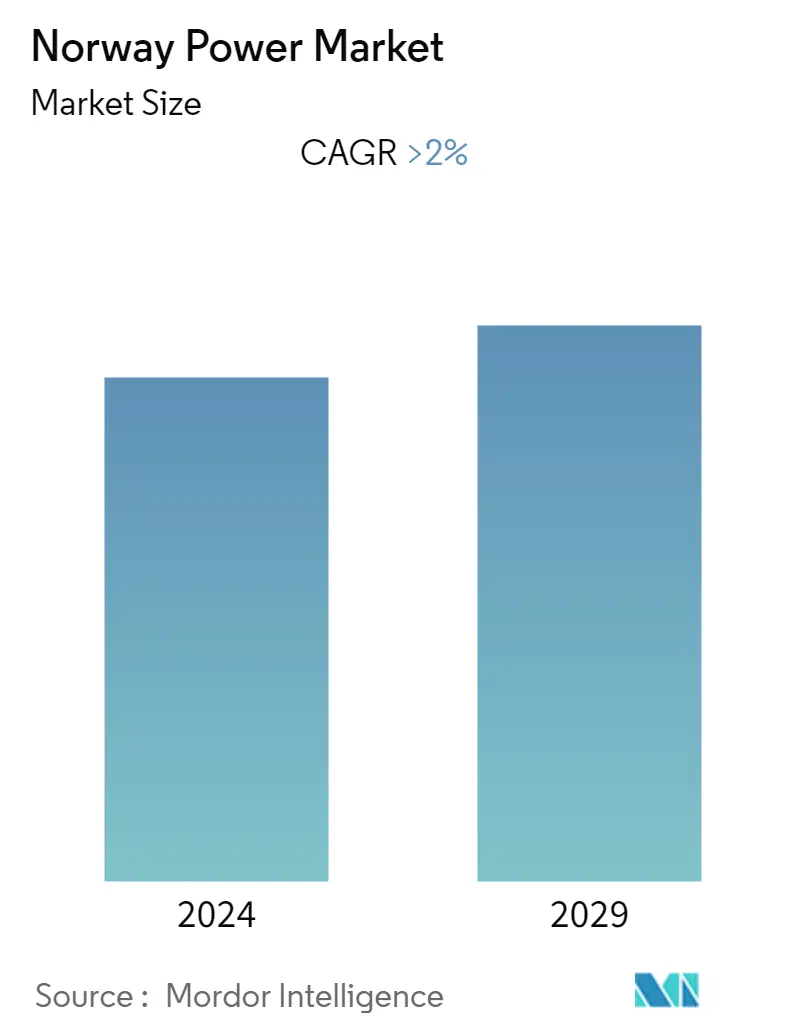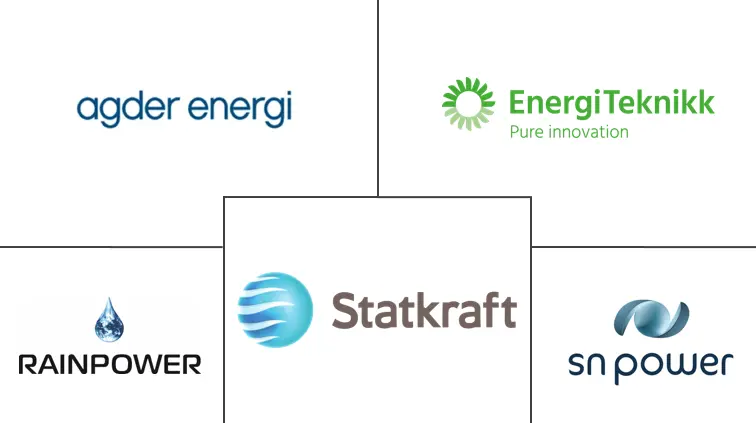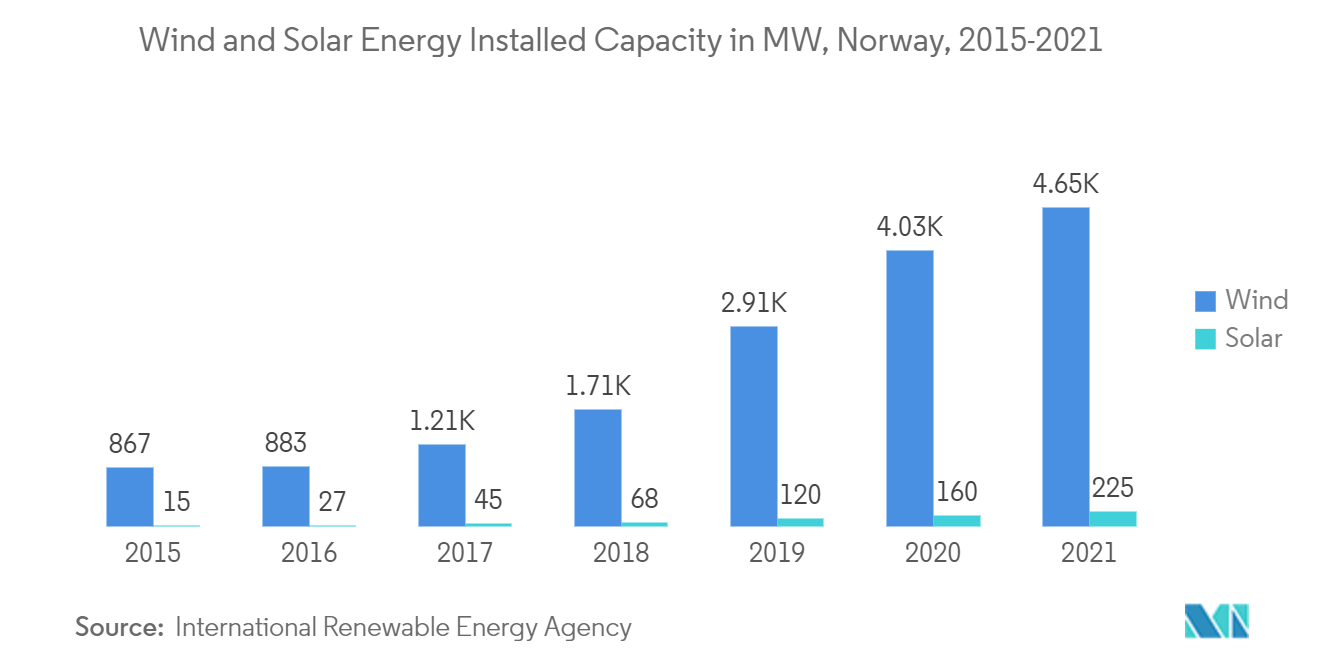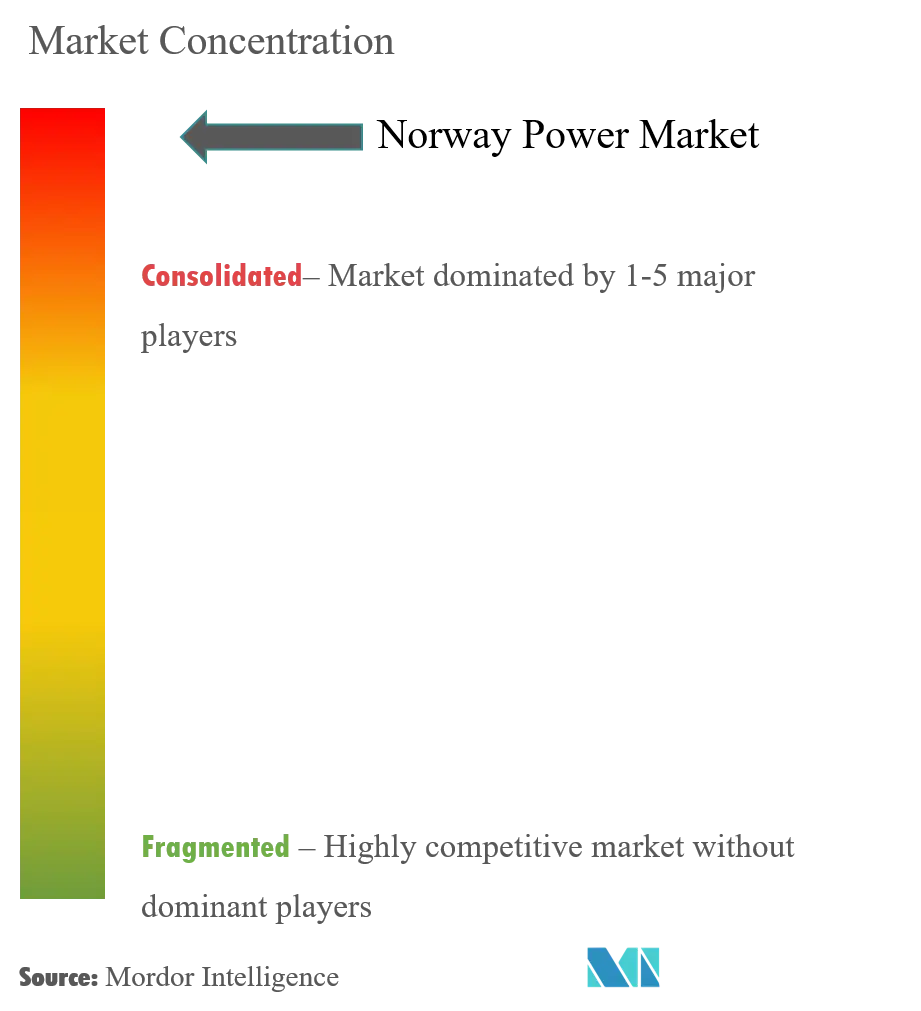Norway Power Market Size

| Study Period | 2021 - 2029 |
| Base Year For Estimation | 2023 |
| Forecast Data Period | 2024 - 2029 |
| Historical Data Period | 2021 - 2022 |
| CAGR | 2.00 % |
| Market Concentration | Low |
Major Players
*Disclaimer: Major Players sorted in no particular order |
Norway Power Market Analysis
The Norwegian power market is expected to record a CAGR of more than 2% during the forecast period.
The Norway power market was negatively impacted by the COVID-19 pandemic due to regional lockdowns and decreased power demand. However, the market rebounded in 2022.
Over the medium term, factors like a rising population, and the development of power generation systems, are spurred by increasing demand for electricity in the country. The phasing out of coal-based power plants in the country, which had a major effect on demand for power plants, continues to promote the use of renewable power sources. However, stringent government regulations and project delays are expected to hinder the growth of the market studied during the forecast period.
The rapidly increasing generation capacity, mostly from hydropower, is expected to increase grid connectivity. This, in turn, is expected to provide significant opportunities for the power sector in the country in the future.
Norway Power Market Trends
This section covers the major market trends shaping the Norway Power Market according to our research experts:
Hydropower Is Expected to Dominate the Market
Hydropower accounts for most of the Norwegian power generation. As of 2021, Norway has around 1660 hydropower plants, which account for 34813 MW of total installed capacity.
So much of Norway's electricity can be generated from hydropower due to the natural advantage of its topography, with abundant steep valleys and rivers. Norway has more than 1000 hydropower storage reservoirs with a total capacity of more than 865 TWh. The 30 largest reservoirs provide about half the storage capacity. Total reservoir capacity corresponds to 70% of annual Norwegian electricity consumption. Norway's largest reservoir, Blåsjø, has a capacity of 7.8 TWh.
Due to the geographic factors and hydro potential, the hydropower sector is expected to continue its dominance in the market studied during the forecast period.

Renewable Potential is Expected to Drive the Market
In Norway, most of the electricity production comes from renewable energy sources. Hydropower is the source of most of the electricity generation in the country. Wind and solar energy also contribute to Norwegian electricity production.
The European Union has committed to increasing the share of renewable energy from 16% to 27% by 2030. Together with the wind, solar energy will account for most of the replacement of fossil fuels. Norway is closely linked to the European energy market.
Production and consumption of energy from renewable sources have been steadily increasing. As of 2021, the generation of renewable in Norway was 154 TWh. There are considerable potential and growth in renewable power generation, and the government expects the total share of renewable power generation to rise in the coming years.
Wind energy has the greatest potential for exploitation in Norway. Wind power accounted for only a relatively modest share of production capacity but dominated investments and held an installed capacity of 4650 MW in 2021. Factors like cheaper energy storage, reduced cost, smart grids, and digitalization drive solar power production. Norway is in the development stage of solar power production. The installed capacity reached 225 MW in 2021.
Hence, a large renewable energy potential, declining costs of renewable energy technologies, and upcoming projects are expected to drive the market studied during the forecast period.

Norway Power Industry Overview
The Norwegian power market is consolidated. Some of the key players in this market are (in no particular order) Statkraft AS, Agder Energi SA, Energi Teknikk AS, Rainpower Holding AS, and SN Power AS.
Norway Power Market Leaders
-
Statkraft AS
-
Agder Energi SA
-
Energi Teknikk AS
-
Rainpower Holding AS
-
SN Power AS
*Disclaimer: Major Players sorted in no particular order

Norway Power Market News
In June 2022, Statkraft commissioned two new small hydropower plants in Norway, located on opposite sides of the Hardanger mountain plateau. The Vesle Kjela and Storlia plants will produce enough electricity to power around 4,000 Norwegian households annually.
Norway Power Market Report - Table of Contents
1. INTRODUCTION
- 1.1 Scope of the Study
- 1.2 Market Definition
- 1.3 Study Assumptions
2. EXECUTIVE SUMMARY
3. RESEARCH METHODOLOGY
4. MARKET OVERVIEW
- 4.1 Introduction
- 4.2 Installed Power Generating Capacity and Forecast in GW, till 2027
- 4.3 Recent Trends and Developments
- 4.4 Government Policies and Regulations
-
4.5 Market Dynamics
- 4.5.1 Drivers
- 4.5.2 Restraints
- 4.6 Supply Chain Analysis
- 4.7 PESTLE Analysis
5. MARKET SEGMENTATION
-
5.1 By Power Generation
- 5.1.1 Thermal
- 5.1.2 Hydropower
- 5.1.3 Renewables
- 5.2 By Power Transmission and Distribution
6. COMPETITIVE LANDSCAPE
- 6.1 Mergers and Acquisitions, Joint Ventures, Collaborations, and Agreements
- 6.2 Strategies Adopted by Leading Players
-
6.3 Company Profiles
- 6.3.1 Statkraft AS
- 6.3.2 Agder Energi SA
- 6.3.3 Energi Teknikk AS
- 6.3.4 Rainpower Holding AS
- 6.3.5 SN Power AS
- *List Not Exhaustive
7. MARKET OPPORTUNITIES AND FUTURE TRENDS
** Subject To AvailablityNorway Power Industry Segmentation
The generation of electricity through various sources like fossil fuels, renewable energies, nuclear energy, etc., and the transmission and distribution of electricity to the end user is considered the power market.
The market is segmented by sector into power generation (thermal, hydropower, and nuclear) and transmission and distribution. The market sizing and forecasts have been done based on electricity generation capacity (MW).
| By Power Generation | Thermal |
| Hydropower | |
| Renewables |
Norway Power Market Research FAQs
What is the current Norway Power Market size?
The Norway Power Market is projected to register a CAGR of greater than 2% during the forecast period (2024-2029)
Who are the key players in Norway Power Market?
Statkraft AS , Agder Energi SA , Energi Teknikk AS , Rainpower Holding AS and SN Power AS are the major companies operating in the Norway Power Market.
What years does this Norway Power Market cover?
The report covers the Norway Power Market historical market size for years: 2021, 2022 and 2023. The report also forecasts the Norway Power Market size for years: 2024, 2025, 2026, 2027, 2028 and 2029.
Norway Power Industry Report
Statistics for the 2024 Norway Power market share, size and revenue growth rate, created by Mordor Intelligence™ Industry Reports. Norway Power analysis includes a market forecast outlook to 2029 and historical overview. Get a sample of this industry analysis as a free report PDF download.



